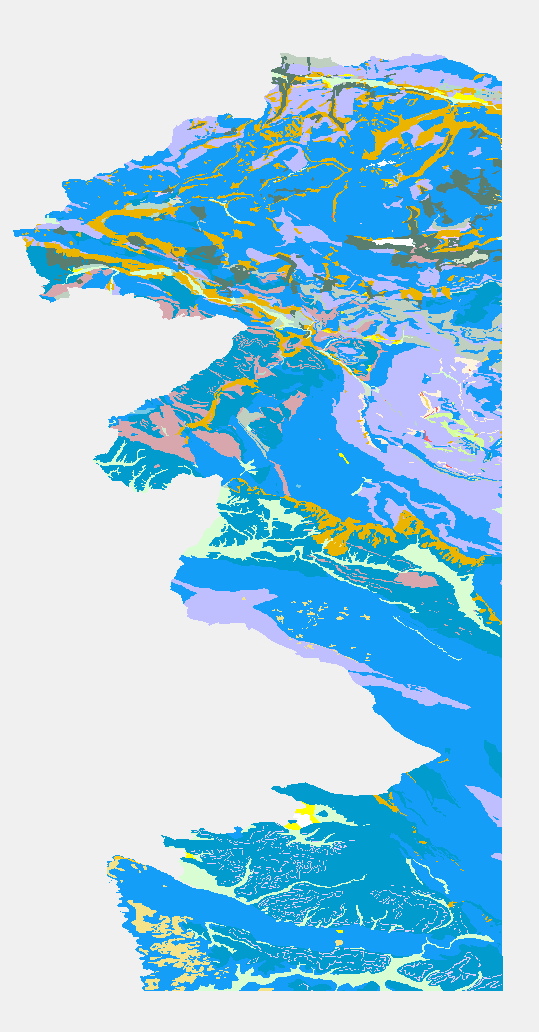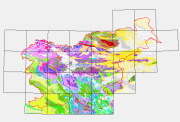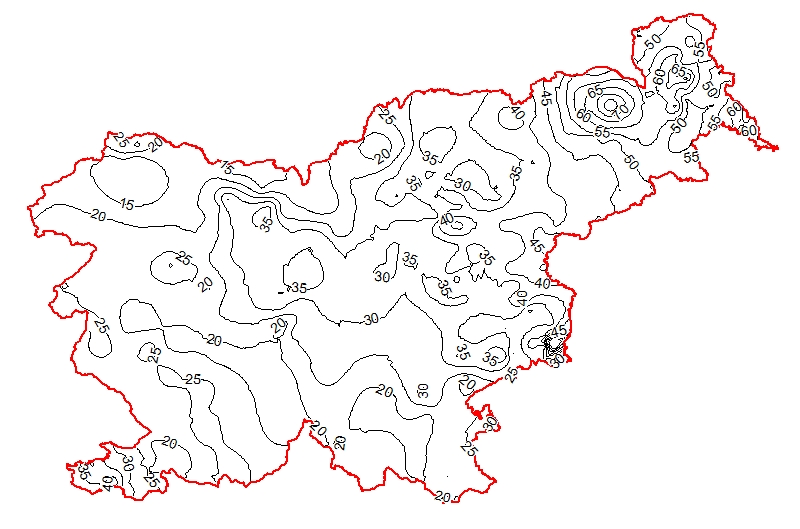Keyword
Nacionalno
17 record(s)
Type of resources
Categories
INSPIRE themes
Keywords
Formats
Representation types
Scale
Resolution
-

The pilot aplication service for calculating landslide susceptibility map and map of flood prone area.The harmonized geological map of Slovenia is a simplified version of the 1:250,000 scale Geological Map of Slovenia (Buser, 2009), which was compiled using the Basic Geological Map of Slovenia at a scale of 1: 100,000 (compiled by various authors between 1960's and 1980's) with the addition of new information by S. Buser. The map depicts the lithostratigraphic composition of Slovenia.The Basic Geological Map of Slovenia as a part of joint Basic Geological Map of SFR Yugoslavia presents lithological and stratigraphic characteristics of rocks, their relationships, age and other. It is a key to the understanding of the geology of Slovenia. It consists of 23 sheets at a scale of 1: 100,000.
-

The harmonized geological map of Slovenia at a scale of 1:1,000,000 is a simplified version of the 1:250,000 scale Geological Map of Slovenia (Buser, 2009). The latter was compiled from the Basic Geological Map of Slovenia at a scale of 1: 100,000 (contributed by various authors between 1960's and 1980's and updated with new information gathered by S. Buser). The map is basically lithostratigraphic. The two layers incorporated in the map are lithostratigraphic units and major faults. The faults depicted on the map were selected using two criteria; regional extent and tectonic importance. The map presented here was edited specifically for the purpose of the OneGeology-Europe project by M. Bavec, M. Novak, M. Poljak, M. Trajanova and D. Skaberne.
-

The Basic Geological Map of Slovenia as a part of joint Basic Geological Map of SFR Yugoslavia presents lithological and stratigraphic characteristics of rocks, their relationships, age and other. It is a key to the understanding of the geology of Slovenia. It consists of 23 sheets at a scale of 1: 100,000.
-
Izpolnitev obveze iz 5. člena Uredbe o posebnih varstvenih območjih (območjih Natura 2000) in seznanitev javnosti z območji NATURA 2000. Podatkovni niz je del evidence območij, ki so pomembna za ohranjanje biotske raznovrstnosti.Natura 2000 je evropsko omrežje posebnih varstvenih območij, razglašenih v državah članicah Evropske unije z osnovnim ciljem ohraniti biotsko raznovrstnost za bodoče rodove. Posebna varstvena območja so torej namenjena ohranjanju živalskih in rastlinskih vrst ter habitatov, ki so redki ali na evropski ravni ogroženi zaradi dejavnosti človeka. Podatkovni niz je uraden podatek za veljavna območja NATURA 2000, ki so bila sprejeta z Uredbo o posebnih varstvenih območjih (območjih Natura 2000) (Uradni list RS, št. 49/04, 110/04, 59/07, 43/08, 8/12, 33/13, 35/13 - popr., 39/13 - odl. US, 3/14, 21/16 in 47/18). Podatkovni niz prikazuje območja NATURA 2000 določena na podlagi direktive o pticah (Direktiva Sveta 79/409/EGS z dne 2. aprila 1979 o ohranjanju prosto živečih ptic) - SPA območja, in direktive o habitatih (Direktiva Sveta 92/43/EGS z dne 21. maja 1992 o ohranjanju naravnih habitatov ter prosto živečih živalskih in rastlinskih vrst) - pSCI/SAC območja.
-

Basic geological map of Yugoslavia presents lithological and stratigraphic characteristics of rocks, their relationships, age and other. It is a key to the understanding of the geology of Slovenia. It consists of 23 sheets, scale 1: 100.000.
-

Consolidated Cadastre of Public Infrastructure is an official register of public utilities and infrastructure objects (road network, railway network, water supply network, sewage network, electricity network, telecommunications) and broadband network termination points of public telecommunication networks. For each object, information about its type, location, identification number and information about infrastructure owner are included in the cadastre. The identification number, location data, data on minimum capacity of the termination point and of its ownership are managed for the broadband network termination points. All utility companies - managers of the public infrastructure and owners of the network termination points are required to provide data for the register. Information from the Consolidated Cadastre of Public Infrastructure is available to the public. The basic goal of the establishment of the consolidated Cadastre of Public Infrastructure is to provide information about location of public infrastructure for the whole country, especially for the spatial planning purposes, for the prevention of unnecessary damage on the infrastructure and for more economical management of the public infrastructure.
-
Mineral deposits and resources
-

The underground geothermal conditions can be presented, irrespective of the aquifers' position, with the appropriate geothermal maps. This map represents the expected isotherms at a depth of 2000 m and is derived from Geothermal map - Expected temperatures at a depth of 2000 m, which is made with data from 240 boreholes. It is made on the basis of measured temperatures in accessible boreholes throughout the country. However, since the temperature field depends on the geological structure in the depths and tectonic characteristics, the course of the isotherms is a result of many influences, such as thermal conductivity of rocks, permeability and fracturing of rocks, all of which are reflected in the measured temperatures in boreholes. In this depth also a radiogenic heat production in the rocks has smaller influence. The distribution of boreholes, which were useful for the measurement of temperature, is very uneven and different as regard the depths. Following the expected temperatures at a depth of 2000 m a stronger positive anomaly is in the northeastern part of Slovenia, from the line Maribor-Rogatec to the east, while in the eastern part of the Krka basin the anomaly is not so much visible any more. In the northeastern part of the country the anomaly is the result of the thinning of the Earth's crust and greater conductive heat flow from the Earth's mantle.
-

The underground geothermal conditions can be presented, irrespective of the aquifers' position, with the appropriate geothermal maps. This map represents the expected isoterms at a depth of 1000 m and is derived from Geothermal map - Expected temperatures at a depth of 1000 m, which is made with data from 302 boreholes. It is made on the basis of measured temperatures in accessible boreholes throughout the country. However, since the temperature field depends on the geological structure in the depths and tectonic characteristics, the course of the isotherms is a result of many influences, such as thermal conductivity of rocks, permeability and fracturing of rocks, all of which are reflected in the measured temperatures in boreholes. The distribution of boreholes, which were useful for the measurement of temperature, is very uneven and different as regard the depths. Following the expected temperatures at a depth of 1000 m a stronger positive anomaly is in the northeastern part of Slovenia, especially between Maribor and Murska Sobota and further to the Hungarian border and at Lendava, as well as in a smaller eastern part of the Krka basin. In the northeastern part of the country the anomaly is the result of the thinning of the Earth's crust and greater conductive heat flow from the Earth's mantle.
-

Map represents the calculated (surface) heat-flow density (HFD) in mW/m2 with topographic correction. It is made with data from 119 boreholes from the measured temperatures in the available boreholes and measured thermal conductivity on cored rock samples from the same boreholes. The pattern of the HFD isolines is affected by numerous parameters, particularly the thermal conductivity of rocks, rock permeability and fracturing, fluid content of the rocks, and all are reflected in the measured temperature gradient in the boreholes.
 TEST - Slovenski INSPIRE metapodatkovni sistem
TEST - Slovenski INSPIRE metapodatkovni sistem